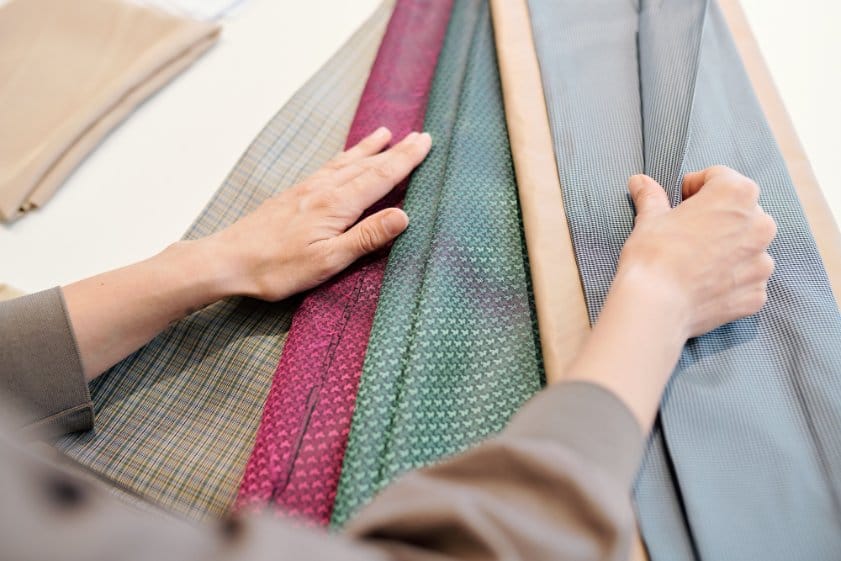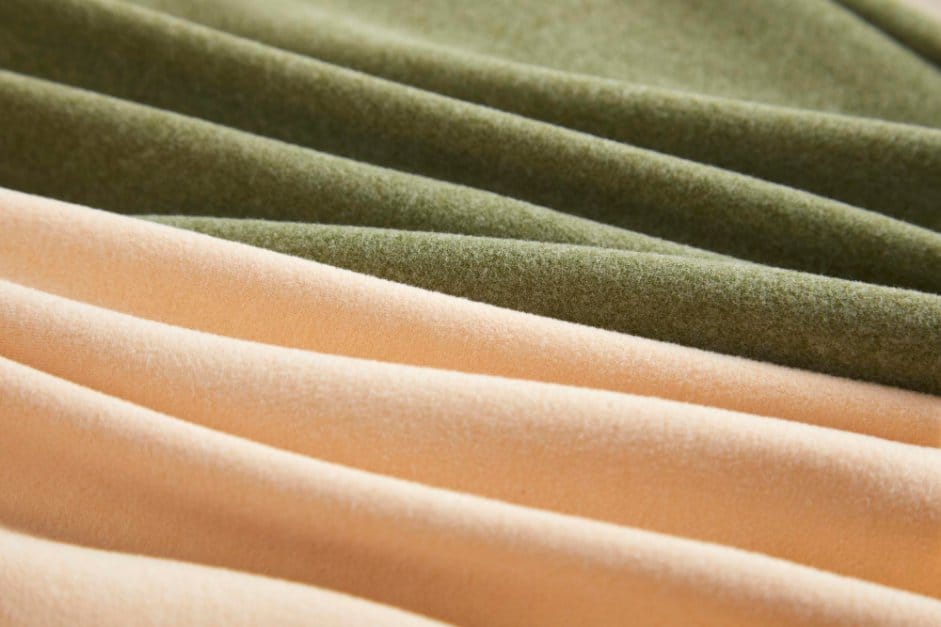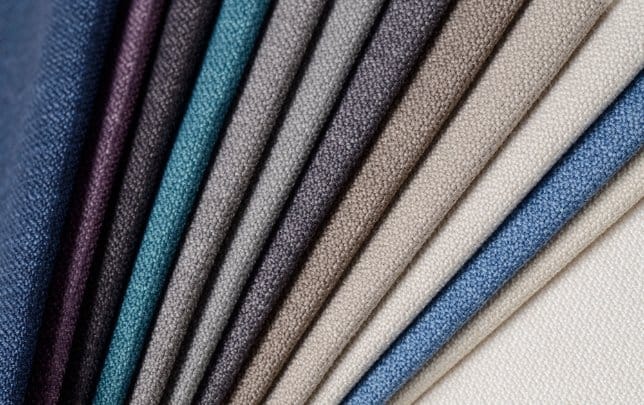From Natural Fibers to Smart Textiles: Everything You Need to Know About Fabric Types, Properties, and Selection
Fabric is a flexible material made by weaving, knitting, or bonding fibers together to create textiles for clothing, home furnishings, and countless other applications. From the cotton t-shirt you wear to the silk curtains in your living room, fabric surrounds us in every aspect of daily life.
Understanding fabric helps you make better choices when shopping for clothes, decorating your home, or starting creative projects. This guide covers everything from basic fiber types to advanced production methods and sustainable practices.
Table of Contents
Key Takeaways
- Fabrics fall into three main categories: woven (like denim), knitted (like t-shirts), and non-woven (like felt)
- Natural fibers come from plants and animals, while synthetic fibers are human-made through chemical processes
- Modern fabric production combines traditional techniques with cutting-edge technology for better performance and sustainability
- Understanding fabric properties helps you choose the right material for specific uses and care requirements
What is Fabric? Understanding the Basics
A fabric is any material made from interlacing, interloping, or bonding fibers together. Think of it as taking individual threads and combining them to create something stronger and more useful than the parts alone.
The terms “fabric” and “textile” are often used the same way, but there’s a small difference. Textiles refer to any material made from fibers, including rope and thread. Fabric specifically means textiles that can be used to make clothing, home goods, or other flexible items.
Yarns form the building blocks of most fabrics. These long, continuous strands are created by twisting individual fibers together, similar to how you might braid hair to make it stronger.
The 3 Main Types of Fabric
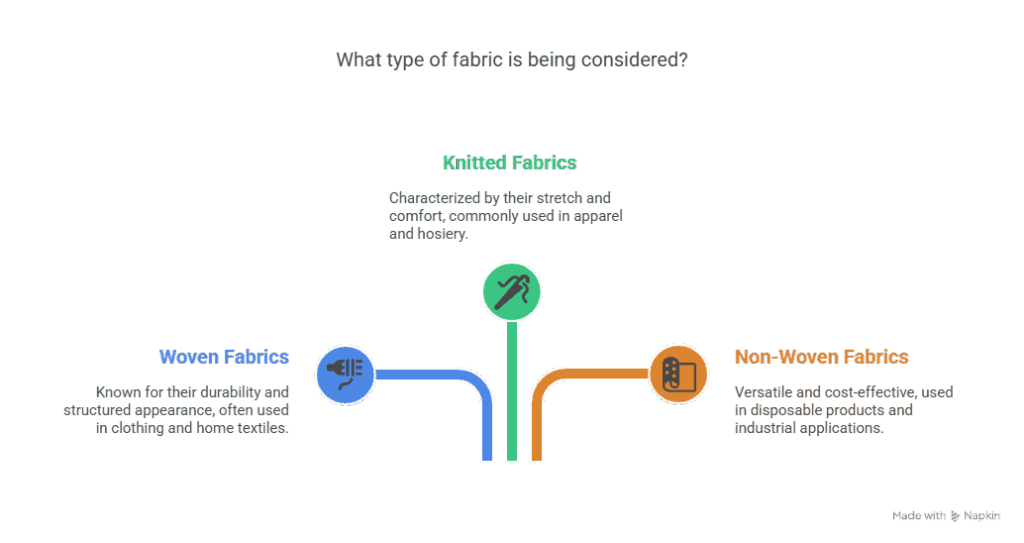
All fabrics fall into three basic categories based on how they’re made:
1. Woven Fabrics
Woven fabrics are created by interlacing two sets of yarns at right angles. The lengthwise yarns (called the warp) stay stationary while crosswise yarns (the weft) go over and under them.
Common woven fabrics include:
- Cotton canvas
- Denim jeans
- Silk scarves
- Wool suits
- Linen shirts
2. Knitted Fabrics
Knitted fabrics use interconnected loops of yarn, similar to hand knitting but done by machine. This construction makes them stretchy and comfortable.
Popular knitted fabrics:
- T-shirt jersey
- Sweater knits
- Athletic wear
- Socks
- Underwear
3. Non-Woven Fabrics
Non-woven fabrics are made by pressing, bonding, or fusing fibers together without weaving or knitting. These are often used for disposable or specialty items.
Examples of non-woven fabrics:
- Felt
- Interfacing for sewing
- Medical gowns
- Coffee filters
- Cleaning wipes
Fabric Classification System
| Category | Construction Method | Stretch | Common Uses | Examples |
|---|---|---|---|---|
| Woven | Interlaced yarns | Low | Structured clothing, upholstery | Denim, canvas, silk |
| Knitted | Interlocked loops | High | Casual wear, activewear | Jersey, ribbing, fleece |
| Non-woven | Bonded/pressed fibers | Variable | Specialty items, disposables | Felt, interfacing, filters |
Natural vs. Synthetic Fibers: Understanding Your Options

Natural Fibers
Natural fibers come from plants, animals, or minerals. They’ve been used for thousands of years and offer unique benefits.
Plant-Based Natural Fibers:
- Cotton: Soft, breathable, and easy to care for. Perfect for everyday clothing
- Linen: Made from flax plants, it’s cool and gets softer with each wash
- Hemp: Durable and naturally antimicrobial
- Bamboo: Naturally moisture-wicking and silky smooth
Animal-Based Natural Fibers:
- Wool: Naturally water-resistant and temperature-regulating
- Silk: Strong, lustrous, and naturally temperature-adaptive
- Cashmere: Ultra-soft wool from cashmere goats
- Alpaca: Warmer than wool and naturally hypoallergenic
Synthetic Fibers
Synthetic fibers are created through chemical processes, often from petroleum products. They offer consistent properties and can be engineered for specific uses.
Common synthetic fibers:
- Polyester: Wrinkle-resistant and holds color well
- Nylon: Strong, elastic, and quick-drying
- Acrylic: Wool-like warmth without the price
- Rayon: Made from wood pulp, feels similar to natural fibers
- Spandex/Lycra: Provides stretch and shape recovery
Fabric Weight and Texture Guide
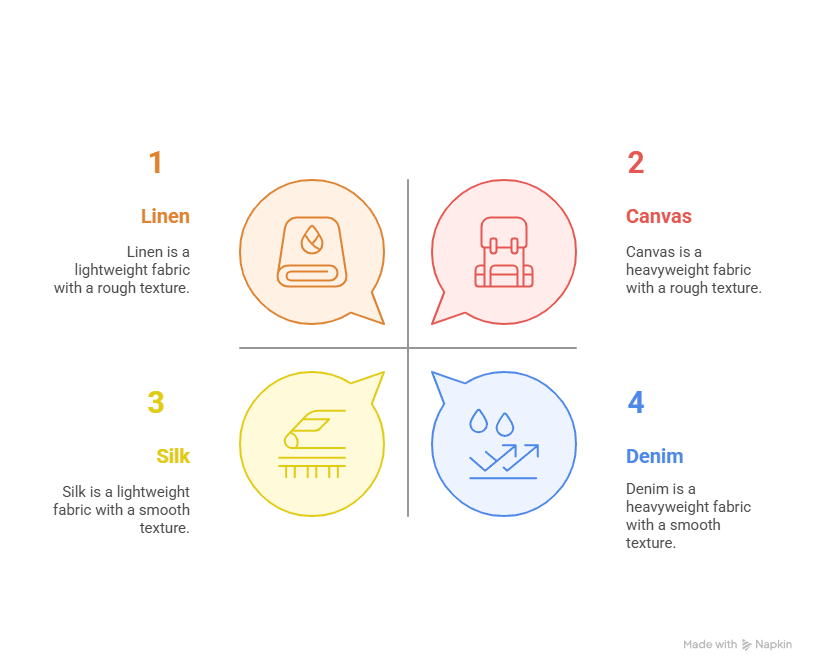
Understanding fabric weight helps you choose the right material for your project. Fabric weight is measured in GSM (grams per square meter) or oz/sq yard.
Lightweight Fabrics (Under 150 GSM)
- Chiffon: Sheer and flowing
- Voile: Thin cotton fabric, perfect for summer
- Georgette: Slightly textured and drapey
- Organza: Crisp and transparent
Medium Weight Fabrics (150-350 GSM)
- Poplin: Smooth cotton with a slight sheen
- Broadcloth: Plain weave cotton, good for shirts
- Twill: Diagonal weave pattern, like in chinos
- Jersey knit: Stretchy and comfortable
Heavyweight Fabrics (Over 350 GSM)
- Denim: Heavy cotton twill, called different weights by oz/sq yard
- Canvas: Heavy cotton fabric, great for bags and upholstery
- Wool coating: Dense wool for coats and jackets
- Corduroy: Ribbed cotton fabric
Fabric Properties and Performance
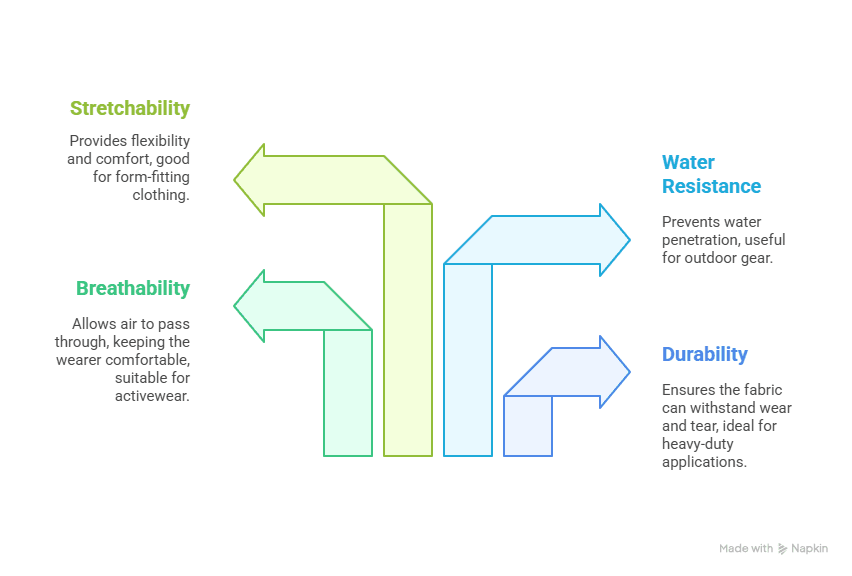
Different fabrics have unique properties that make them suitable for specific uses. Here’s what to consider:
Breathability
Some fabrics allow air to pass through better than others:
- Most breathable: Linen, cotton, hemp
- Moderately breathable: Wool, rayon
- Least breathable: Polyester, vinyl, rubber-coated fabrics
Moisture Management
How fabric handles sweat and water:
- Moisture-wicking: Polyester blends, merino wool, bamboo
- Quick-drying: Nylon, polyester
- Absorbent: Cotton, linen (but slow to dry)
Durability Rankings
From most to least durable:
- Canvas and heavy cotton
- Denim
- Wool
- Polyester blends
- Silk
- Linen
- Delicate knits
Historical Journey of Fabric
Fabric production dates back over 30,000 years, making it one of humanity’s most important inventions. Understanding this history helps explain why certain fabrics are valued today.
Ancient Beginnings (3000-500 BCE)
Early civilizations discovered they could twist plant fibers into strong threads. Ancient Egyptians perfected linen production from flax plants around 5000 BCE, creating fabric so fine it’s still admired today.
The discovery of spinning wheels and simple looms allowed people to create increasingly complex textiles. Wool from sheep and goats provided warm, durable clothing for colder climates.
The Silk Road Era (500 BCE – 1500 CE)
Chinese silk became one of the world’s most valuable trade goods. The Silk Road connected Asia to Europe, spreading not just silk but also:
- Cotton techniques from India
- Wool processing methods from Central Asia
- Natural dyeing techniques
- Decorative weaving patterns
During this period, fabric quality showed social status. Wealthy people wore silk and fine wool, while common people used rougher linen and simple cotton.
Industrial Revolution Changes (1760-1840)
The invention of the power loom in 1784 changed everything. Machine-made textiles became cheaper and available to more people. Key innovations included:
- Spinning jenny: Could spin multiple threads at once
- Water frame: Made stronger, finer threads
- Power loom: Automated weaving process
- Cotton gin: Made cotton processing much faster
This period also saw the creation of denim in France, originally made from a silk-wool blend before evolving into the cotton fabric we know today.
Modern Textile Production

Today’s fabric production combines traditional methods with advanced technology to create better-performing, more sustainable materials.
Fiber to Yarn: The Spinning Process
Modern spinning converts loose fibers into strong, uniform yarns through several methods:
Ring Spinning: Creates the smoothest, strongest yarns. Cotton and wool often use this method.
Open-End Spinning: Produces yarns quickly but with a slightly rougher texture. Good for casual clothing.
Air-Jet Spinning: Makes very uniform yarns with minimal waste. Often used for synthetic blends.
The spinning process affects your fabric’s final feel and performance. Longer staple fibers (longer individual fibers) generally create smoother, stronger yarns.
Weaving Patterns and Techniques
Basic Weave Structures
Plain Weave: The simplest pattern where weft yarns go over one, under one warp yarn. Creates strong, stable fabrics like:
- Poplin
- Canvas
- Taffeta
- Muslin
Twill Weave: Creates diagonal lines by offsetting the over-under pattern. Results in:
- Denim
- Gabardine
- Herringbone
- Chino fabric
Satin Weave: Yarns float over several others before going under, creating a smooth, lustrous surface:
- Satin fabric
- Sateen (cotton version)
- Some silk fabrics
Dyeing and Printing Revolution
Modern fabric coloring has become more precise and environmentally conscious:
Digital Printing: Computer-controlled systems can create detailed, complex patterns with less water waste than traditional methods.
Natural Dyes: Plant-based colors are making a comeback for eco-conscious consumers, though they may not be as colorfast as synthetic dyes.
Solution Dyeing: Adding color during fiber production creates more permanent, fade-resistant colors.
Smart Fabrics and Modern Innovation
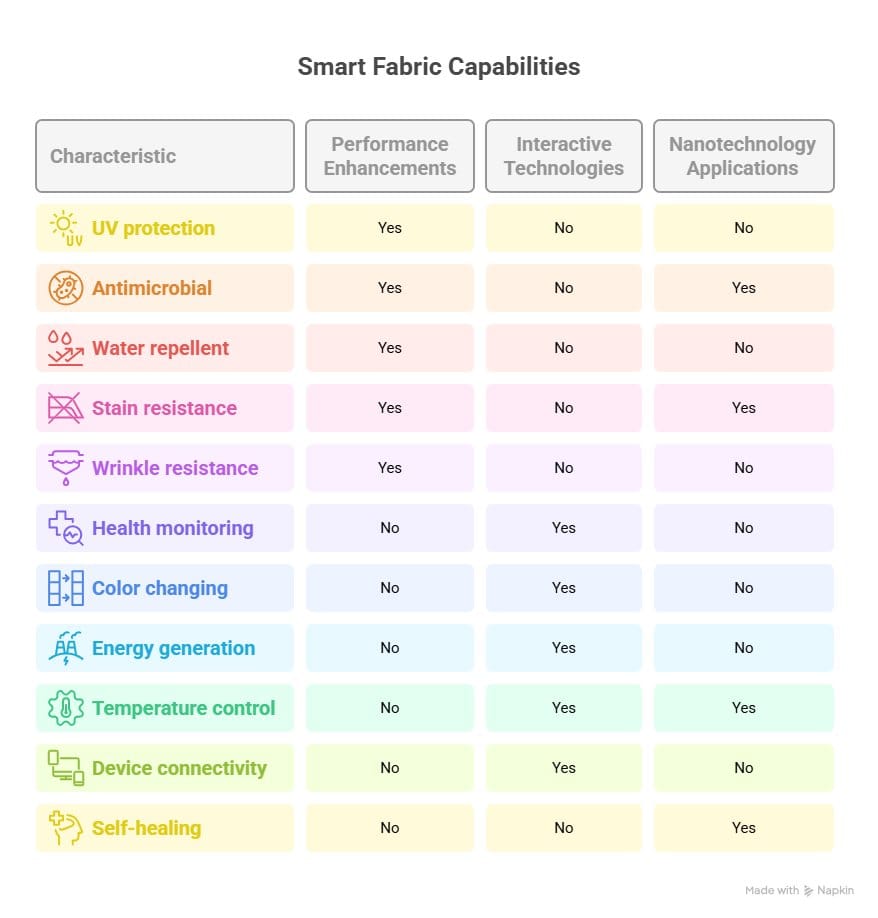
Today’s textiles can do much more than just cover and protect. Smart fabrics represent the cutting edge of textile technology.
Performance Enhancements
Modern fabrics can be treated to provide specific benefits:
- UV protection: Blocks harmful sun rays
- Antimicrobial treatment: Prevents odor-causing bacteria
- Water repellent: Beads water without being completely waterproof
- Stain resistance: Makes cleanup easier
- Wrinkle resistance: Reduces ironing needs
Interactive Technologies
The newest smart fabrics can:
- Monitor heart rate and body temperature
- Change color based on temperature or light
- Generate small amounts of electricity from body movement
- Provide heating or cooling on demand
- Connect to smartphones and other devices
Nanotechnology Applications
Microscopic particles added to fabrics create amazing properties:
- Self-cleaning fabrics that break down stains when exposed to light
- Fabrics that can kill bacteria and viruses on contact
- Materials that can heal small tears automatically
- Textiles that provide superior insulation while staying lightweight
Sustainable and Eco-Friendly Fabrics
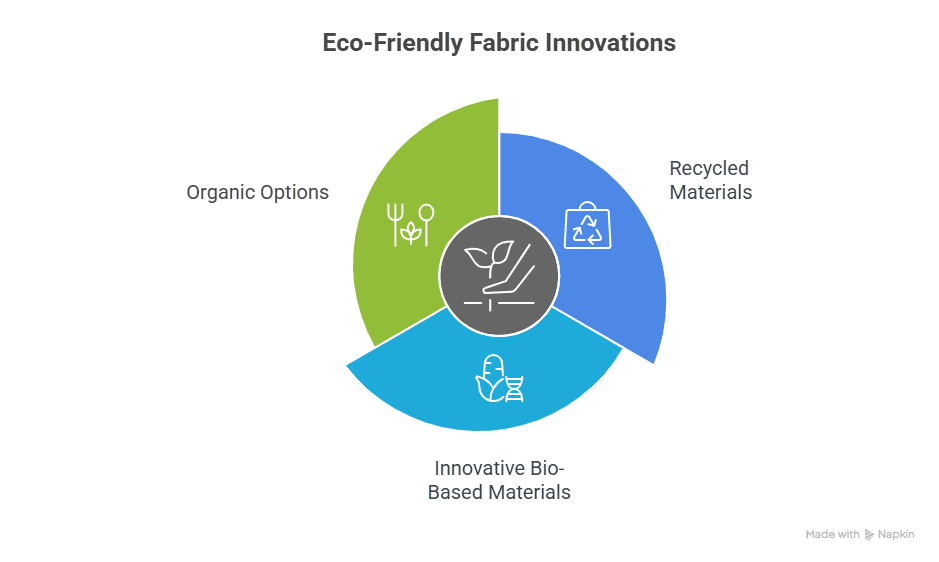
Environmental concerns are driving innovation in sustainable textile production. The fashion industry is one of the world’s largest polluters, making eco-friendly fabrics increasingly important.
Recycled Materials
New technologies turn waste into wearable fabrics:
- Recycled polyester: Made from plastic bottles and textile waste
- ECONYL: Regenerated nylon from fishing nets and fabric scraps
- Recycled cotton: Breaks down used cotton items to create new fiber
- Recycled wool: Processes wool sweaters and fabric waste
Innovative Bio-Based Materials
Scientists are developing fabrics from unexpected sources:
- Mushroom leather: Made from mushroom roots (mycelium)
- Pineapple leather: Created from pineapple leaf waste
- Orange fiber: Made from citrus industry byproducts
- Algae-based fabrics: Use algae oil for synthetic fibers
Organic Options
Organic fabrics are grown without harmful pesticides:
- Organic cotton: Uses 91% less water than conventional cotton
- Organic hemp: Naturally pest-resistant, requires minimal water
- Organic linen: Made from organically grown flax
- Peace silk: Harvested without harming silkworms
Fabric Care and Maintenance Guide
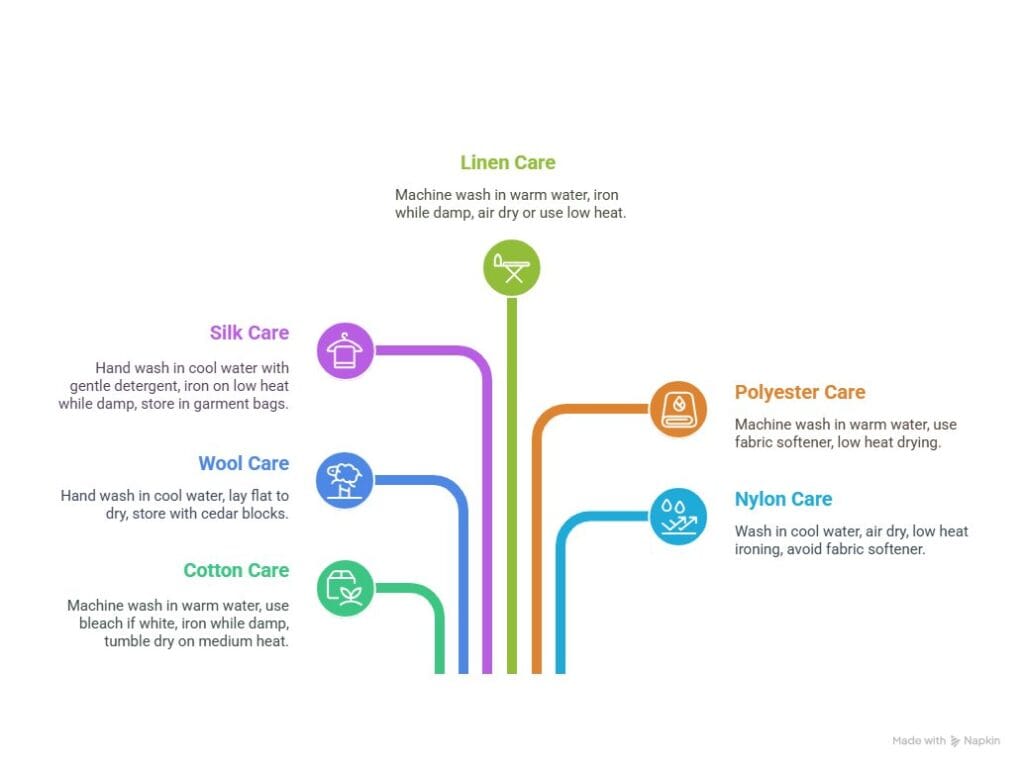
Proper care extends fabric life and maintains appearance. Different fabrics need different approaches:
Natural Fiber Care
Cotton Care:
- Machine wash in warm water
- Can handle bleach if white
- Iron while slightly damp for best results
- Tumble dry on medium heat
Wool Care:
- Hand wash in cool water or use wool cycle
- Never wring or twist
- Lay flat to dry
- Store with cedar blocks to prevent moths
Silk Care:
- Hand wash in cool water with gentle detergent
- Never twist or wring
- Iron on low heat while slightly damp
- Store in breathable garment bags
Linen Care:
- Machine wash in warm water
- Gets softer with each wash
- Iron while damp for crisp appearance
- Can air dry or use low heat in dryer
Synthetic Fiber Care
- Machine wash in warm water
- Use fabric softener to reduce static
- Low heat drying
- Iron on low heat if needed
Nylon:
- Wash in cool water to prevent snagging
- Air dry when possible
- Low heat ironing
- Avoid fabric softener
Quality Assessment: How to Judge Fabric
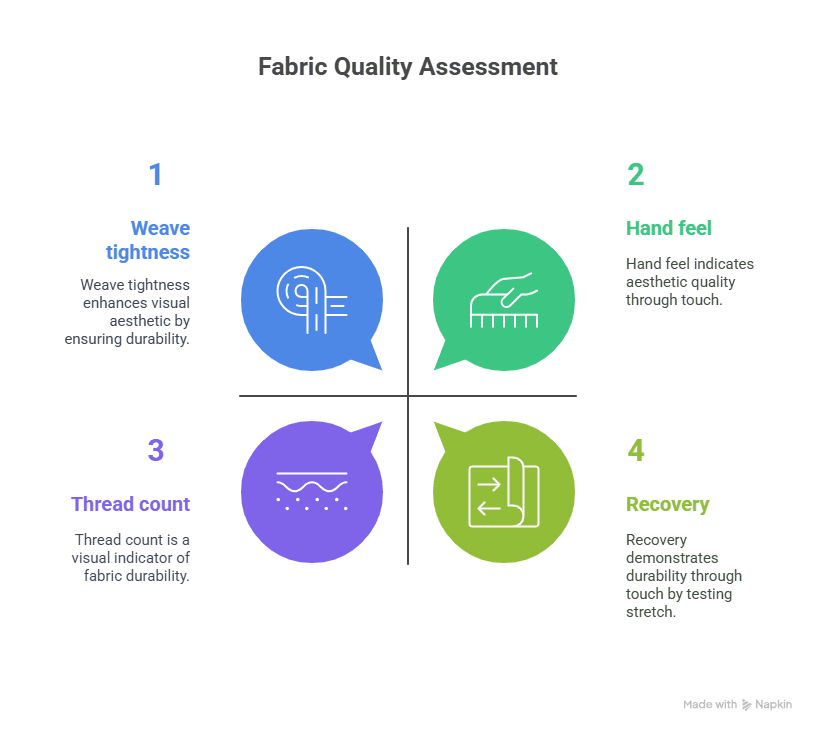
Learning to evaluate fabric quality helps you make better purchasing decisions:
Visual Inspection
- Weave tightness: Closer weaves generally last longer
- Color consistency: Even coloring indicates quality production
- Surface smoothness: Check for loose threads or irregularities
- Pattern alignment: Stripes and plaids should match at seams
Touch Test
- Hand feel: Quality fabrics feel substantial without being stiff
- Drape: Fabric should hang naturally
- Recovery: Stretch fabrics should bounce back quickly
- Texture: Consistent texture indicates even fiber distribution
Durability Indicators
- Thread count: Higher counts often mean better quality (but not always)
- Fiber length: Longer staple fibers create stronger fabrics
- Twist level: Proper yarn twist prevents excessive pilling
- Edge finish: Quality fabrics have clean, finished edges
Cost Analysis: Fabric Pricing Factors
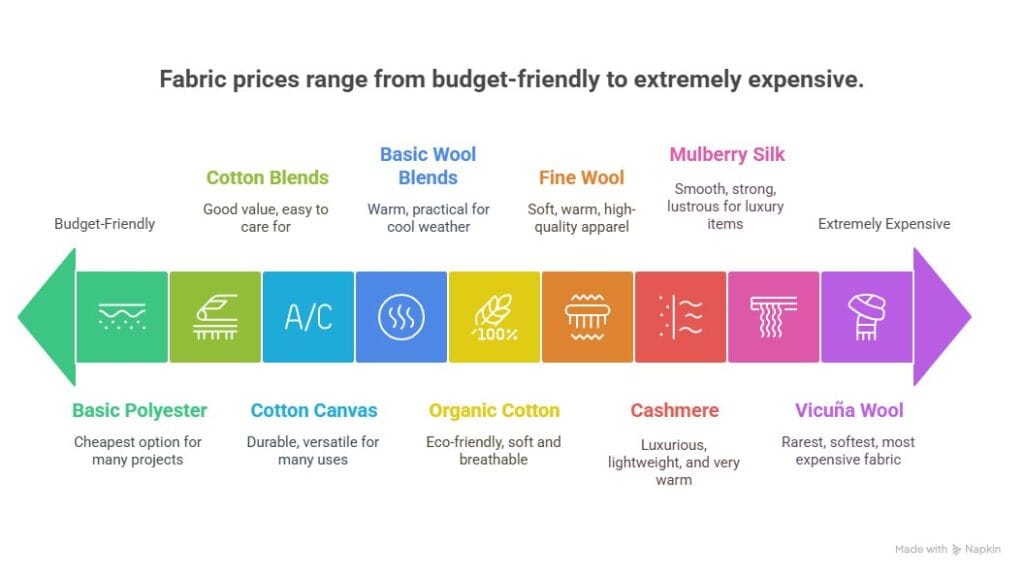
Understanding what affects fabric prices helps you budget for projects:
Most Expensive Fabrics
- Vicuña wool: Can cost $3,000-5,000 per yard
- Mulberry silk: High-grade silk costs $100-300 per yard
- Cashmere: Pure cashmere runs $50-200 per yard
- Fine wool: Merino and other premium wools cost $30-100 per yard
- Organic cotton: Premium organic cotton costs $15-50 per yard
Budget-Friendly Options
- Cotton blends: $5-15 per yard
- Basic polyester: $3-10 per yard
- Cotton canvas: $8-20 per yard
- Basic wool blends: $15-30 per yard
Price Factors
- Fiber quality: Natural fibers typically cost more than synthetic
- Construction complexity: Intricate weaves increase price
- Brand reputation: Designer fabrics command premium prices
- Production scale: Small batch fabrics cost more per yard
- Finishing treatments: Special treatments add to base cost
Regional Fabric Specialties

Different regions excel at producing specific types of fabric:
Asian Specialties
- Chinese silk: Mulberry silk production perfected over millennia
- Japanese denim: Premium raw denim with traditional techniques
- Indian cotton: Known for lightweight, breathable cottons
- Thai silk: Distinctive texture and vibrant colors
European Excellence
- Italian wool: World-renowned suiting fabrics
- Irish linen: High-quality flax processing traditions
- Scottish wool: Tweeds and premium knits
- French silk: Luxury fabrics and advanced weaving techniques
American Innovations
- Denim heritage: Original blue jean fabric development
- Cotton production: Large-scale, consistent cotton farming
- Technical fabrics: Performance and outdoor gear materials
- Sustainable innovation: Leading eco-friendly fabric development
Troubleshooting Common Fabric Problems
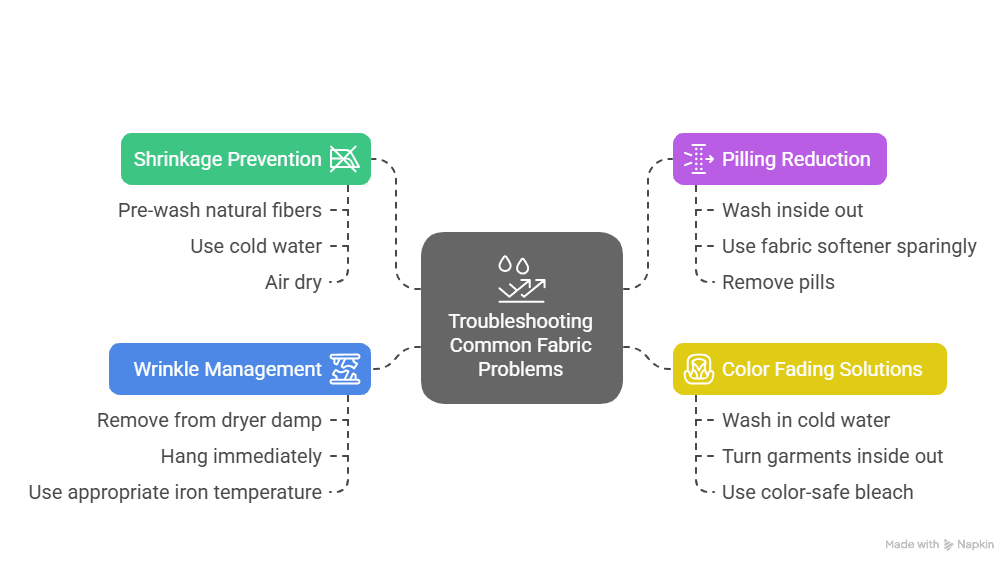
Shrinkage Prevention
- Pre-wash natural fibers before sewing
- Use cold water for first few washes
- Air dry when possible
- Check care labels carefully
Pilling Reduction
- Wash inside out
- Use fabric softener sparingly
- Remove pills with fabric shaver
- Choose tighter weaves when possible
Color Fading Solutions
- Wash in cold water
- Turn garments inside out
- Use color-safe bleach alternatives
- Dry away from direct sunlight
Wrinkle Management
- Remove from dryer while slightly damp
- Hang immediately after washing
- Use appropriate iron temperature
- Consider wrinkle-resistant treatments
Fabric Selection for Specific Uses

Best Fabrics for Sensitive Skin
- Organic cotton: No chemical treatments
- Bamboo: Naturally hypoallergenic
- Silk: Smooth surface reduces irritation
- Merino wool: Finer fibers feel softer
Most Durable Workwear Fabrics
- Canvas: Heavy cotton for maximum durability
- Ripstop nylon: Tear-resistant synthetic
- Duck cloth: Heavy cotton twill
- Cordura: Textured nylon for extreme durability
Humid Climate Fabrics
- Linen: Maximum breathability
- Cotton voile: Lightweight and airy
- Bamboo blends: Natural moisture-wicking
- Lightweight wool: Natural temperature regulation
Cold Weather Fabrics
- Wool: Natural insulation and water resistance
- Fleece: Synthetic insulation that stays warm when wet
- Down-proof nylon: For outerwear shells
- Merino wool: Base layer that doesn’t retain odors
Fabric Industry Statistics and Trends
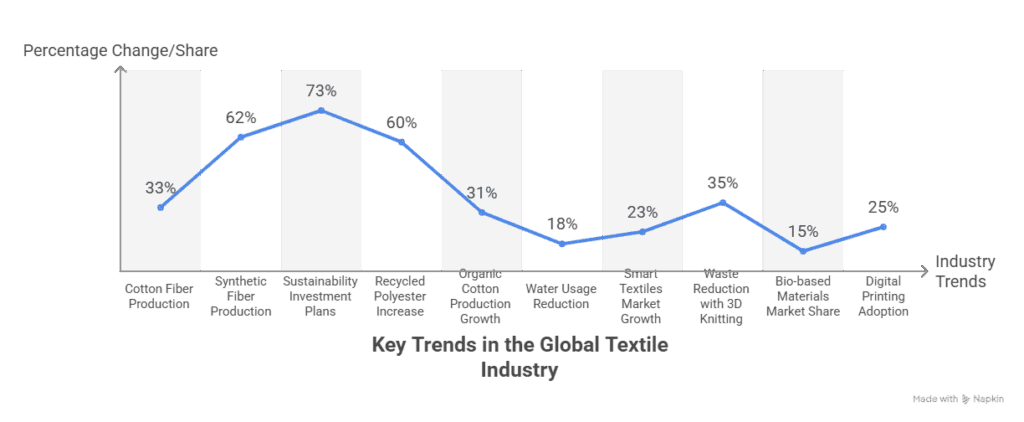
The global textile market continues to evolve rapidly:
Market Size
- Global textile market worth approximately $993 billion in 2023
- Expected to reach $1.4 trillion by 2030
- Cotton represents about 33% of global fiber production
- Synthetic fibers account for roughly 62% of production
Sustainability Trends
- 73% of global fashion executives plan to increase sustainability investments
- Recycled polyester use increased 60% from 2020 to 2023
- Organic cotton production up 31% in the last five years
- Water usage in textile production decreased 18% through new technologies
Innovation Areas
- Smart textiles market growing at 23% annually
- 3D knitting technology reducing waste by up to 35%
- Bio-based materials expected to capture 15% market share by 2030
- Digital printing adoption increasing 25% year-over-year
Frequently Asked Questions
Is there a difference between textile and fabric?
Yes, but it’s subtle. Textiles include all materials made from fibers, including rope, thread, and fabric. Fabric specifically refers to textiles that can be made into clothing, home goods, or other flexible items. All fabrics are textiles, but not all textiles are fabrics.
What is the most common textile material?
Cotton is the most widely used natural fiber globally, representing about one-third of all fiber production. However, when you include synthetic materials, polyester is actually the most common, making up nearly 55% of global fiber production.
What are the names of plain fabrics?
Plain fabrics refer to those with simple weave structures and minimal patterns:
• Muslin (lightweight cotton)
• Poplin (smooth cotton with slight sheen)
• Broadcloth (medium-weight cotton)
• Canvas (heavy cotton)
• Chambray (lightweight cotton with colored warp)
• Percale (crisp cotton, often used for sheets)
What are the names of soft fabrics?
The softest fabrics include:
• Cashmere (ultra-soft goat wool)
• Modal (soft rayon from beech trees)
• Bamboo (naturally silky texture)
• Pima cotton (long-staple cotton)
• Silk (naturally smooth protein fiber)
• Micro modal (extra-fine modal fibers)
• Supima cotton (premium American cotton)
What is heavy cotton fabric called?
Heavy cotton fabrics have specific names based on their weight and weave:
• Canvas: Heavy plain weave cotton (12-16 oz per yard)
• Duck cloth: Heavy cotton twill (10-18 oz per yard)
• Denim: Heavy cotton twill with diagonal ribbing (12-21 oz per yard)
• Bull denim: Heavy cotton twill without the indigo dyeing
• Sailcloth: Extra-heavy canvas (18+ oz per yard)
What type of fabric is commonly used by beginners?
Cotton is the best fabric for beginners because it:
• Forgives mistakes in cutting and sewing
• Doesn’t stretch or shift during sewing
• Takes pins and stitches easily
• Can be pressed and repressed without damage
• Is affordable for practice projects
• Comes in many weights and colors
• Specifically, quilting cotton or cotton broadcloth are ideal starting fabrics.
How many types of textile fabrics are there?
There are hundreds of specific fabric types, but they all fall into the three main construction categories (woven, knitted, non-woven). By fiber content, there are about 20 major fiber types, but when you consider blends, weights, and weave variations, there are over 300 commonly recognized fabric types.
How do you categorize fabrics?
Fabrics can be categorized several ways:
• By Construction: Woven, knitted, or non-woven
• By Fiber Content: Natural (plant, animal, mineral) or synthetic
• By Weight: Lightweight (under 150 GSM), Medium weight (150-350 GSM), Heavyweight (over 350 GSM)
• By Use: Apparel, home textiles, technical/industrial
• By Performance: Stretch/non-stretch, moisture-wicking, thermal properties
What types of fabrics are the most expensive?
The most expensive fabrics typically include:
1. Vicuña wool: $3,000-5,000 per yard (rarest animal fiber)
2. Mulberry silk: $100-500 per yard (highest grade silk)
3. Cashmere: $50-300 per yard (soft goat undercoat)
4. Qiviut: $400-600 per yard (musk ox undercoat)
5. Guanaco wool: $300-400 per yard (wild llama relative)
6. Fine merino wool: $50-150 per yard (premium sheep wool)
Price depends on rarity, processing difficulty, and brand positioning.
What is the name of the thin cotton fabric?
Thin cotton fabrics include:
• Voile: Sheer, plain weave cotton
• Lawn: Fine, crisp cotton
• Batiste: Soft, lightweight cotton
• Organdy: Stiff, sheer cotton
• Gauze: Loose, open weave cotton
• Muslin: Lightweight cotton (though it comes in various weights)
Voile is probably the most common thin cotton fabric.
What are the names of non-denim fabrics?
Non-denim fabrics include virtually all other textiles. Some popular alternatives to denim include:
Other Cotton Fabrics:
• Chino/twill
• Corduroy
• Canvas
• Poplin
• Chambray
Synthetic Options:
• Polyester blends
• Nylon
• Spandex blends
Natural Alternatives:
• Linen
• Hemp
• Wool
• Silk
Knitted Options:
• Jersey
• French terry
• Ponte knit
The question is quite broad since denim is just one specific type of cotton twill fabric.
Conclusion
Understanding fabric opens up a world of better decisions in clothing, home decoration, and creative projects. From the basic difference between woven and knitted construction to the advanced properties of smart textiles, this knowledge helps you choose materials that meet your specific needs and budget.
The textile industry continues evolving rapidly, with sustainability and performance driving innovation. Recycled fibers, bio-based materials, and smart fabrics represent the future of textiles, offering better environmental options and enhanced functionality. As consumers become more conscious of their choices, understanding fabric properties, care requirements, and environmental impact becomes increasingly valuable.
Key Recommendations:
- Start with natural fibers like cotton and linen for everyday use – they’re forgiving, breathable, and improve with proper care
- Invest in quality basics rather than trendy items – well-made fabrics in classic styles provide better long-term value
- Learn to read care labels and follow them – proper care extends fabric life significantly
- Consider the full cost including care requirements and durability when choosing fabrics
- Support sustainable options when possible – organic, recycled, and responsibly produced fabrics benefit both you and the environment
- Test before committing – buy small amounts to test how fabrics perform in your specific use case
- Build fabric knowledge gradually – understanding improves with hands-on experience
Whether you’re shopping for clothes, decorating your home, or starting a creative project, the right fabric choice makes all the difference. Use this guide as your reference, but remember that the best way to understand fabric is through direct experience. Touch different materials, observe how they behave over time, and gradually build your expertise.
The world of textiles offers endless possibilities, from traditional craftsmanship to cutting-edge innovations. By understanding the fundamentals covered in this guide, you’re equipped to make informed decisions and appreciate the remarkable materials that surround us every day.

